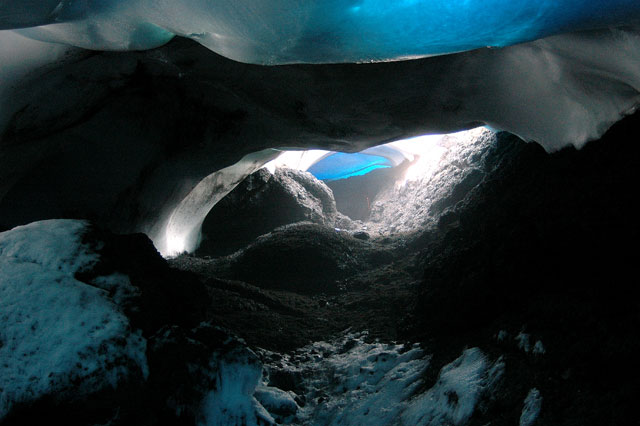|
Page 2/2 - Posted October 26, 2012
Research activities in ice caves to be restricted during 2012-13 field seasonThe paper submitted to the nations that oversee management of the southern continent through the Antarctic Treaty System A database He estimates there are probably another 100 ice caves that no one has yet visited or mapped. An inventory should include a record of every visit and the activities that took place, according to Curtis. “In order to do good science, you need to know what happened before in the caves,” he said. “Having a really good shared dataset is the most important thing.” A small area on the northwest slope of the main crater called Tramway Ridge In the case of Tramway Ridge, located at about 3,400 meters elevation, the area has significant gas emission and its soil has the highest surface temperatures on Mount Erebus. The micro-ecosystem includes an unidentified moss species, as well as a wide variety of thermally tolerant bacteria. A six-square kilometer area on Mount Melbourne Dahood said the United States is working with New Zealand to develop a new ASPA that would fold all three high-altitude geothermal areas into a single, more comprehensive management plan. Particular concern exists because the warmer soils in these areas are inviting to temperate microorganisms that could hitch a ride with a visitor to the area. “They’re not really well represented in the ASPA system,” Dahood said of the geothermal areas. Staudigel said he believes it may not be necessary to formally incorporate the ice caves into an ASPA. He and Curtis will work together this season on Mount Erebus to continue an inventory of the caves and discuss a permanent access and code of contact solution that will be satisfactory for all involved. “Such a code of conduct will have to address issues of access to the caves, the biological cleanliness of equipment and scientists, as well as the minimal impact of activities in these caves,” Staudigel said. “Points of discussions include the cleanliness of instruments, special protection of high temperature zones within the caves and activities such as eating and drinking. “Biologists and geologists need to be on the same page for the conduct of research in such fragile environments,” he added. Curtis agreed, though he added that it is important for people working in caves of such a high-altitude environment to remain fueled with food and to stay hydrated. “We need to protect the caves; we also need to protect the cavers,” he said. The interim code of conduct approved by NSF for the 2012-13 field season restricts activities such as eating and drinking to the cave entrances. It also requires sterilization of instruments that are used in the vents or warm soils, and it prohibits leaving any gear or equipment inside the caves. “Ultimately, all parties involved are working toward a compromise code of conduct that maintains the microbial integrity of these fascinating ecological settings while also allowing for the important measurements that need to be made to understand the outgassing of Mount Erebus,” Staudigel said. NSF-funded research in this story: Phil Kyle and Clive Oppenheimer, New Mexico Tech, Award No. 1142083 |



For USAP Participants |
For The Public |
For Researchers and EducatorsContact UsU.S. National Science FoundationOffice of Polar Programs Geosciences Directorate 2415 Eisenhower Avenue, Suite W7100 Alexandria, VA 22314 Sign up for the NSF Office of Polar Programs newsletter and events. Feedback Form |




